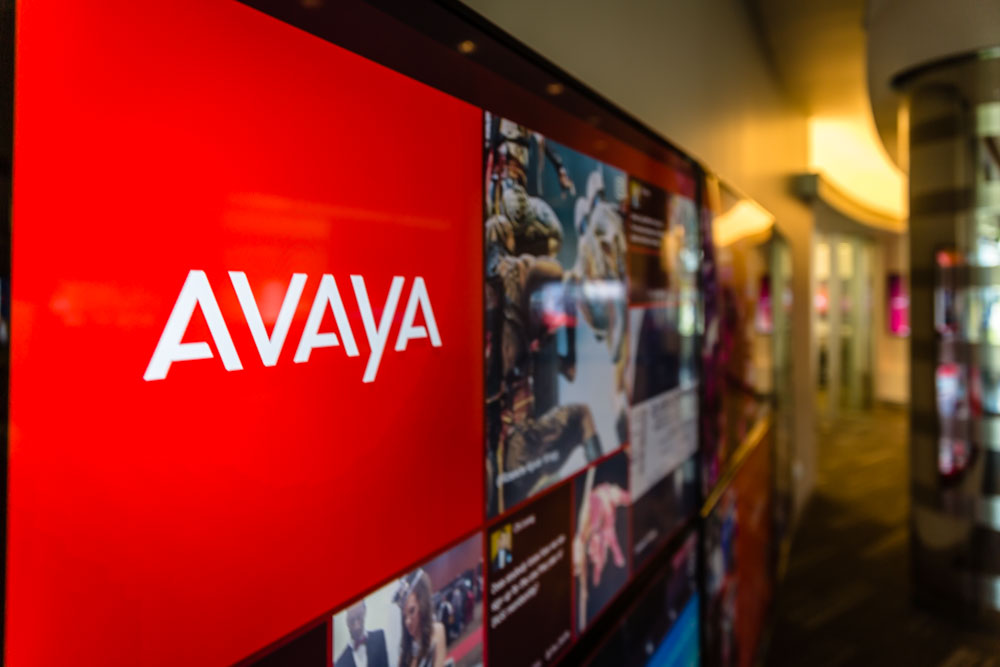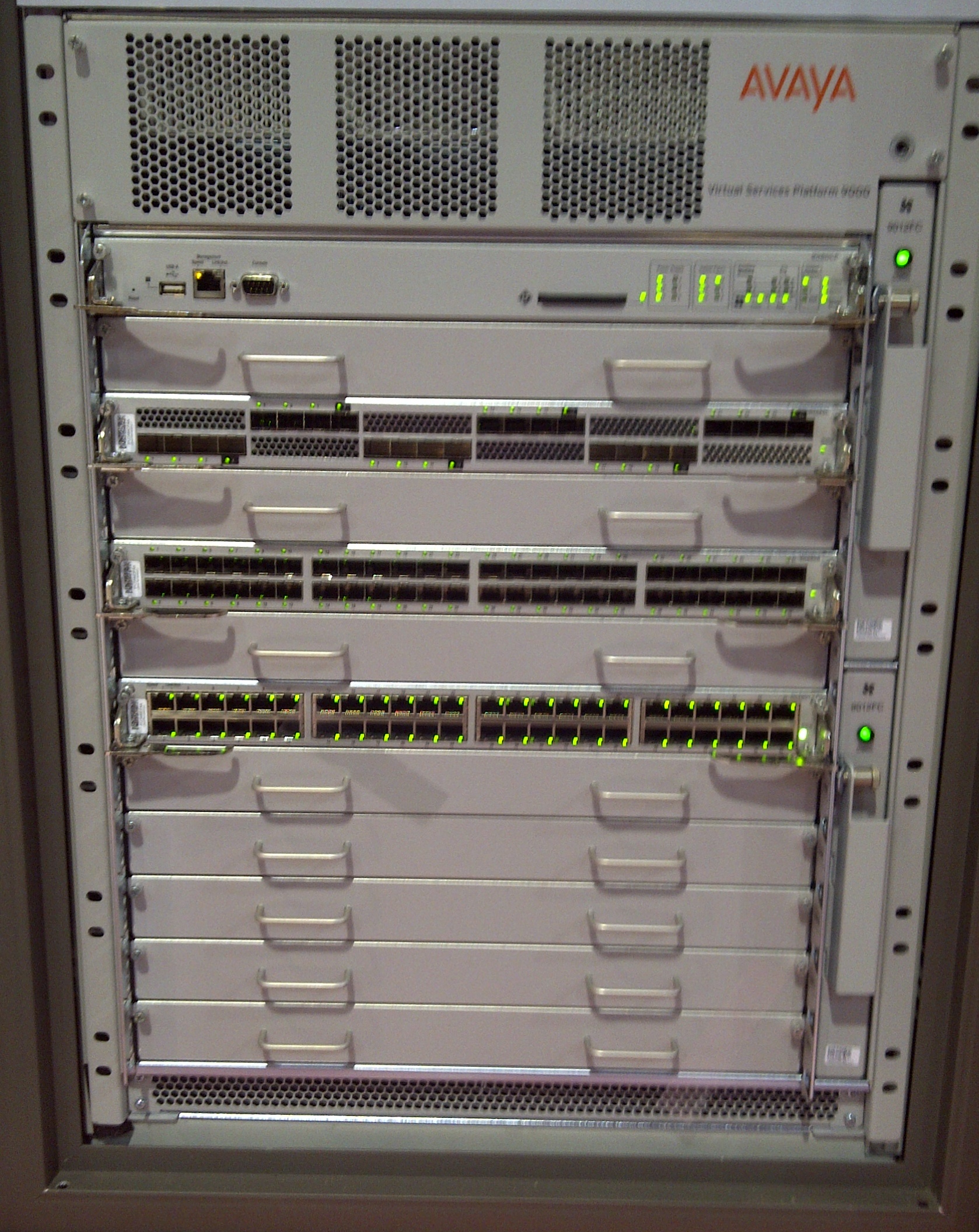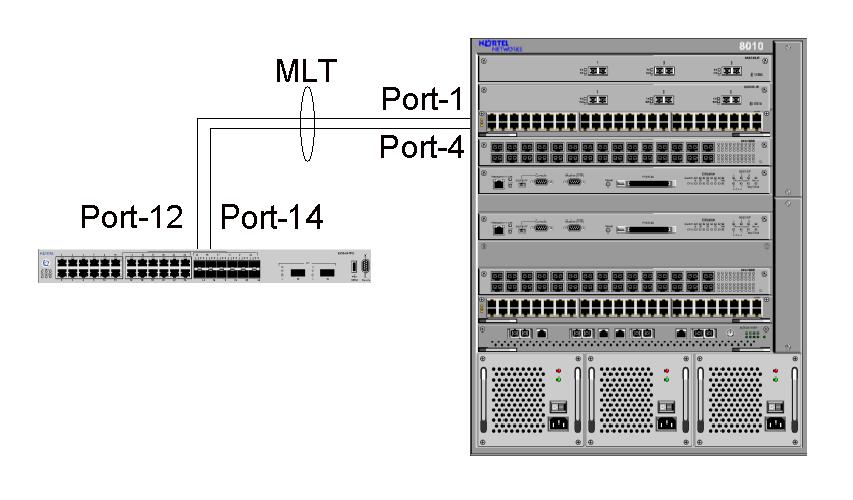|
InterSwitch Trunk
InterSwitch Trunk (IST) is one or more parallel point-to-point links (Link aggregation) that connect two switches together to create a single logical switch. The IST allows the two switches to share addressing information, forwarding tables, and state information, permitting rapid (less than one second) fault detection and forwarding path modification. The link may have different names depending on the vendor. For example, Brocade calls this an Inter-Chassis Link (ICL). Cisco calls this a VSL (Virtual Switch Link). Edge switches, servers or PCs see the two aggregate switches as one large switch. This allows any vendor's equipment configured to use the IEEE 802.3ad static link aggregation protocol to connect to both switches and take advantage of load balancing, redundant connections. The IST protocol was developed by Nortel (now acquired by Avaya, which is now acquired by Extreme Networks) to enhance the capabilities of Link aggregation, and is required to be configured prior to ... [...More Info...] [...Related Items...] OR: [Wikipedia] [Google] [Baidu] |
Link Aggregation
In computer networking, link aggregation is the combining ( aggregating) of multiple network connections in parallel by any of several methods, in order to increase throughput beyond what a single connection could sustain, to provide redundancy in case one of the links should fail, or both. A link aggregation group (LAG) is the combined collection of physical ports. Other umbrella terms used to describe the concept include trunking, bundling, bonding, channeling or teaming. Implementation may follow vendor-independent standards such as Link Aggregation Control Protocol (LACP) for Ethernet, defined in IEEE 802.1AX or the previous IEEE 802.3ad, but also proprietary protocols. Motivation Link aggregation increases the bandwidth and resilience of Ethernet connections. Bandwidth requirements do not scale linearly. Ethernet bandwidths historically have increased tenfold each generation: 10 megabit/s, 100 Mbit/s, 1000 Mbit/s, 10,000 Mbit/s. If one started to bump in ... [...More Info...] [...Related Items...] OR: [Wikipedia] [Google] [Baidu] |
MERS 8600
Metro Ethernet Routing Switch 8600 or MERS 8600 is a modular chassis router and/or switch manufactured by Nortel now acquired by Ciena. The MERS 8600 supports the Provider Backbone Bridges (PBB), Provider Backbone Transport (PBT) technologies and carrier class Operations Administration & Maintenance (OAM) tools. Configurable as a 1.440 Terabit Switch cluster using SMLT and RSMLT protocols, cluster failover (normally less than 100 millisecond). BT uses the MERS 8600 PBB/PBT technologies in its 21st Century Network (21CN) and India has selected this platform for the most extensive IP network ever deployed by an international airport in India. The MERS 8600 has 3 chassis options * 8006, 6-slot chassis for backbones of low density or high space premium * 8010, 10-slot chassis for high availability and high scalability * 8010CO, 10-slot NEBS-compliant chassis. The chassis can be configured with one or two CPU modules (8692SF), and is normally configured with two or three load ... [...More Info...] [...Related Items...] OR: [Wikipedia] [Google] [Baidu] |
Network Architecture
Network architecture is the design of a computer network. It is a framework for the specification of a network's physical components and their functional organization and configuration, its operational principles and procedures, as well as communication protocols used. In telecommunication, the specification of a network architecture may also include a detailed description of products and services delivered via a communications network, as well as detailed rate and billing structures under which services are compensated. The network architecture of the Internet is predominantly expressed by its use of the Internet protocol suite, rather than a specific model for interconnecting networks or nodes in the network, or the usage of specific types of hardware links. OSI model The Open Systems Interconnection model (OSI model) defines and codifies the concept of layered network architecture. Abstraction layers are used to subdivide a communications system further into smaller ma ... [...More Info...] [...Related Items...] OR: [Wikipedia] [Google] [Baidu] |
Ethernet
Ethernet () is a family of wired computer networking technologies commonly used in local area networks (LAN), metropolitan area networks (MAN) and wide area networks (WAN). It was commercially introduced in 1980 and first standardized in 1983 as IEEE 802.3. Ethernet has since been refined to support higher bit rates, a greater number of nodes, and longer link distances, but retains much backward compatibility. Over time, Ethernet has largely replaced competing wired LAN technologies such as Token Ring, FDDI and ARCNET. The original 10BASE5 Ethernet uses coaxial cable as a shared medium, while the newer Ethernet variants use twisted pair and fiber optic links in conjunction with switches. Over the course of its history, Ethernet data transfer rates have been increased from the original to the latest , with rates up to under development. The Ethernet standards include several wiring and signaling variants of the OSI physical layer. Systems communicating over Ethernet ... [...More Info...] [...Related Items...] OR: [Wikipedia] [Google] [Baidu] |
Avaya Government Solutions
Avaya Holdings Corp., often shortened to Avaya (), is an American multinational technology company headquartered in Durham, North Carolina, that provides cloud communications and workstream collaboration services. The company's platform includes unified communications (UCaaS), contact center other services. The company provides services to 220,000 customer locations in 190 countries. History In 1995, Lucent Technologies was spun off from AT&T, and Lucent subsequently spun off units of its own in an attempt to restructure its struggling operations. .html" ;"title="/sup>">/sup> Avaya was then spun off from Lucent as its own company in 2000 (Lucent merged with Alcatel SA in 2006, becoming Alcatel-Lucent, which was purchased in turn by Nokia in 2016). It remained a public company from 2000 to 2007. In October 2007, Avaya was acquired by two private-equity firms, TPG Capital and Silver Lake Partners, for $8.2 billion. On January 19, 2017, Avaya filed for Chapter 11 bankruptcy. ... [...More Info...] [...Related Items...] OR: [Wikipedia] [Google] [Baidu] |
Avaya VSP-9000 System
Avaya Virtual Services Platform 9000 Series or VSP 9000 is a set of modular chassis switches used in enterprise and data center networks, manufactured by Avaya. The VSP 9000 is used by institutions which are suffering from performance limitations, need to simplify their network infrastructure in a virtualized environment, or require 10 Gigabit Ethernet today with the option to scale to 40 or 100 Gigabit Ethernet in the future. It is also an option for companies who are looking to reduce the power and cooling cost in order to maximize the cost-effectiveness of their infrastructures; this unit was also designed and is expected to have a lifespan of seven-to-ten years. In 2013 the Olympics network backbone is built with VSP 9000 Switches supporting 30,000 users and up to 54 terabits per second of traffic. General Specifications The VSP 9000 Series consists of two Chassis models; the original 9012 Chassis supports twelve (12) horizontally-orientated front-panel slots, ten (10 ... [...More Info...] [...Related Items...] OR: [Wikipedia] [Google] [Baidu] |
Avaya VSP-7000 System
Avaya Virtual Services Platform 7000 Series or VSP 7000 is a set standalone/ stackable switches, used in enterprise data networks, and data centers, manufactured by Avaya. This product is primarily offered to satisfy the Top-of-Rack (ToR) role for server farms and virtualized data centers. It supports Avaya's extended Shortest Path Bridging (SPB) implementation "Fabric Connect", and is future-ready for Edge Virtual Bridging (EVB) – IEEE 802.1Qbg, and Fiber Channel over Ethernet (FCoE). The system incorporates fifth generation application-specific integrated circuit (ASIC) chips with redundant and hot-swappable power supplies, fans, and expansion modules. The VSP 7000's unique architecture allows it to be meshed - fully or partially - with like devices, creating a high-capacity, low-latency network of up to 500 units, supporting up to 16,000 ports of 10GbE supported by a virtual backplane of up to 280Tbit/s History In November 2010 Avaya introduced its Virtual Enterprise ... [...More Info...] [...Related Items...] OR: [Wikipedia] [Google] [Baidu] |
Nortel ERS 8600
The Avaya Ethernet Routing Switch 8600 or ERS 8600, previously known as the ''Passport 8600'' or the ''Accelar 8000'', is a modular chassis combination hardware router and switch used in computer networking. The system, originally designed and manufactured by Nortel, was manufactured by Avaya from 2009 until 2017. The system provided the 10G Ethernet equipment backbone for the 2010 Winter Olympics games, providing service for 15,000 VoIP Phones, 40,000 Ethernet connections and supporting 1.8 million live spectators. The system is configurable as a 1.440 Terabit Switch cluster using SMLT and R-SMLT protocols, to provide high reliability cluster failover (normally less than 100 millisecond). There were three chassis options; a 3-slot chassis most commonly used for access or distribution / aggregation of switches which has a MTBF of 2,043,676hr., a 6-slot chassis for backbones of low density or high space premium environments, and a 10-slot chassis for high availability and high scal ... [...More Info...] [...Related Items...] OR: [Wikipedia] [Google] [Baidu] |
Nortel
Nortel Networks Corporation (Nortel), formerly Northern Telecom Limited, was a Canadian multinational telecommunications and data networking equipment manufacturer headquartered in Ottawa, Ontario, Canada. It was founded in Montreal, Quebec, in 1895 as the Northern Electric and Manufacturing Company. Until an antitrust settlement in 1949, Northern Electric was owned principally by Bell Canada and the Western Electric Company of the Bell System, producing large volumes of telecommunication equipment based on licensed Western Electric designs. At its height, Nortel accounted for more than a third of the total valuation of all companies listed on the Toronto Stock Exchange (TSX), employing 94,500 people worldwide. In 2009, Nortel filed for bankruptcy protection in Canada and the United States, triggering a 79% decline of its corporate stock price. The bankruptcy case was the largest in Canadian history and left pensioners, shareholders and former employees with enormous losses. ... [...More Info...] [...Related Items...] OR: [Wikipedia] [Google] [Baidu] |
DMLT
Multi-link trunking (MLT) is a link aggregation technology developed at Nortel in 1999. It allows grouping several physical Ethernet links into one logical Ethernet link to provide fault-tolerance and high-speed links between routers, switches, and servers. MLT allows the use of several links (from 2 up to 8) and combines them to create a single fault-tolerant link with increased bandwidth. This produces server-to-switch or switch-to-switch connections that are up to 8 times faster. Prior to MLT and other aggregation techniques, parallel links were underutilized due to Spanning Tree Protocol’s loop protection. Fault-tolerant design is an important aspect of Multi-Link Trunking technology. Should any one or more than one link fail, the MLT technology will automatically redistribute traffic across the remaining links. This automatic redistribution is accomplished in less than half a second (typically less than 100 millisecond) so no outage is noticed by end users. This high speed ... [...More Info...] [...Related Items...] OR: [Wikipedia] [Google] [Baidu] |
Multi-Link Trunking (MLT)
Multi-link trunking (MLT) is a link aggregation technology developed at Nortel in 1999. It allows grouping several physical Ethernet links into one logical Ethernet link to provide fault-tolerance and high-speed links between routers, switches, and servers. MLT allows the use of several links (from 2 up to 8) and combines them to create a single fault-tolerant link with increased bandwidth. This produces server-to-switch or switch-to-switch connections that are up to 8 times faster. Prior to MLT and other aggregation techniques, parallel links were underutilized due to Spanning Tree Protocol’s loop protection. Fault-tolerant design is an important aspect of Multi-Link Trunking technology. Should any one or more than one link fail, the MLT technology will automatically redistribute traffic across the remaining links. This automatic redistribution is accomplished in less than half a second (typically less than 100 millisecond) so no outage is noticed by end users. This high speed ... [...More Info...] [...Related Items...] OR: [Wikipedia] [Google] [Baidu] |




.jpg)
